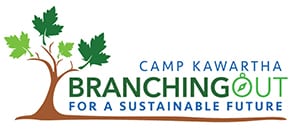Camp Kawartha Capital Campaign
Branching Out for a Sustainable Future
There are so many issues facing children today, from climate change, to habitat destruction and from pollution to overpopulation. It is easy to become discouraged in the face of what seems like a bleak future. At Camp Kawartha we believe that environmental education is an act of hope. That we can inspire children to become active caretakers of their own communities by showing what effective, sustainable living looks like and by teaching them to appreciate, protect and enhance the living systems that nurture us all
Every child, at every age can engage in simple acts of green. Whether it means creating a pollinator garden or planting a tree – whether it means naturalizing a shoreline or finding ways to become more energy efficient, we all can make our communities more nature rich and our lives more sustainable. At Camp Kawartha, we want to foster the next generation of environmental leaders. Camp Kawartha also recognizes it takes a village to foster stewardship. This is work that we cannot undertake alone.
That is why we are inviting you to join us on our journey as we work towards our future of becoming a provincial leader in the delivery of environmental and outdoor education programming.

Camp Kawartha Today….
Camp Kawartha is a recognized camp, outdoor education and environmental learning centre which reaches more than 12,000 people per year. Camp Kawartha has earned 16 awards for its work in connecting children to their environment. It’s mission is to foster environmental stewardship.
Vision for the Future….
Camp Kawartha has embarked on a remarkable journey, investing in its facilities to become a provincially recognized leader in environmental education. This will be achieved by showcasing sustainable living in action, through teaching nature and outdoor awareness and by fostering tomorrow’s environmental stewards. Every renovation and addition that will come to fruition through our campaign will be a teaching tool to show what is possible in sustainable design.
If you are interested in being part of our Branching Out For a Sustainable Future Campaign Team or would like to make a donation in order to realize this vision – please contact Jacob Rodenburg, Executive Director – Together, we can create a sustainable future for our children and those many generations yet to come!
About the Project
The priorities of our campaign are as follows:
Central Hub Addition & Renovation
Camp Kawartha’s current dining hall was built in the 1960’s. It is poorly insulated and sits on piers. The plan is to remove the current hall and replace it with a “central hub” consisting of a dining hall and sleeping quarters, all demonstrating the latest in green architecture. This certified “living building,”would be the first of its kind in all of Canada. From living wall and a living roof, to rainwater collection, from geothermal heating to using all-natural materials, the central hub would show how people and nature can live together and be healthy for both. The hub would be a designated as a net zero building (zero toxins, zero waste and zero carbon), a showpiece for sustainability.Accommodations added at the back of the new hall will improve accessibility for those with limited mobility. In addition, the current Health Centre will be moved into the hub, so that it can more effectively look after the overall health needs of visitors. This innovative renovation will allow Camp Kawartha to modestly increase its Outdoor Education, Facility Rental, and Summer Camp capacity by 30%, helping to expand our mission of fostering stewardship to campers, students and visitors regionally, provincially and nationally.
Greening of Buildings
Our sleeping cabins were constructed in the 1960’s. While they’ve been upgraded, they aren’t well insulated. We’d like to replace each of these with an exemplar of innovative green design. Each cabin would be a unique example of what is possible in sustainable design. For example, a cabin made entirely out of reclaimed materials, another out of straw, another out of rammed earth. Each cabin becomes a teaching opportunity, demonstrating to our campers, students and visitors how inspiring green buildings can be.

